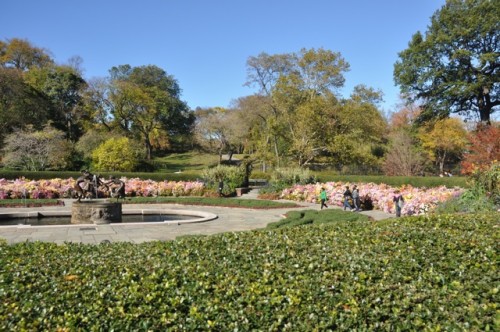When my info-larder gets too packed, it’s time to serve up some choice nuggets from around the Web.
 Get’em while they’re hot.
Get’em while they’re hot.
Locally groan in the East Village
Peter Meehan is probably the ultimate New York hipster food writer. He lives in the East Village (not Greenpoint or Carrol Gardens, but still). He’s 33. He “plays guitar in a musty, atmospheric psych-folk band that includes Magik Markers member Pete Nolan and Sonic Youth skins-thumper Steve Shelley.” He cowrote last year’s It cookbook with perennially It chef David Chang. In his spare time, he writes for The New York Times — most recently, it seems, a regular column called Grass Fed.
Meehan’s latest column, on the tendency to self-righteousness among hardcore locavores, has generated much discussion on Twitter. I have two things to say about it: 1) The kid can write and 2) The kid is right.
Insofar as the sustainable food movement is about consumption — buying this and not that — then snobbery, over-earnestness, and tsk-tsk-ing of people’s personal choices is devastating. It turns off out-of-the-know consumers; and there goes the growth prospects of your consumers’ movement. Memo to judgmental and/or snotty locavores: meet people where they are.
The trouble with old-school ‘agrarian-urbanism’
Over on Design Observer, Harvard landscape architecture department chair Charles Waldheim has a learned essay on the history of what he calls “agrarian urbanism” — self-conscious attempts to incorporate agrarian features into cityscapes. Waldheim reminds us that the current fixation on designing urban spaces around food production has a history dating to the 1930s. Waldheim sums these past agrarian-urbanist projects like this: “Implicit in the work of these urbanists were two large assumptions: that cities would continue to be decentralized, and that landscape would become the primary medium of urban form.”
In other words, what these designers — including Frank Lloyd Wright and “Broadacre City” (1934-35) — were really dreaming up were low-density suburban spaces with lots of green space for growing plants. And it’s precisely these sorts of ideas that the urban theorist Jane Jacobs savaged in her seminal 1961 book The Death and Life of Great American Cities. For Jacobs, such plans weren’t so much about designing cities as about “decontaminating” cities of the very density that makes them productive (and, as we know know, ecologically robust). While thinking through these past agrarian-urban projects is important, I’m more interested in intensive agriculture that’s shoehorned into high-density, truly urban spaces. That tradition, as I argued in my opening essay for our recent Feeding the City series, has a history, too — one dating to the very origin of cities.
The kids are all right
Anim Steel is the long-time director of the Boston-based Food Project, one of the nation’s original and leading urban agriculture and food-justice organizations. He has a new essay called “Youth and Food Justice: Lessons from the Civil Rights Movement” [PDF]. It’s too important to be discussed briefly here — I’ll try to get to it next week — but I want to urge people to read it. If we’re going to get beyond the consumerist dilemmas described by Meehan above, it’s going to be through the kind of political organizing and movement building promoted by Steel.
Feel the veggie-love
Do attempts to coin new catchphrases ever work? Sometimes, maybe. But I’m skeptical of “vegivore” — “a term that connotes fervid vegetable love rather than ardent meat hate” — even though I like the idea. In New York Magazine, authors Robin Raisfeld and Rob Patronite invented that phrase in a piece describing a new veggie-mania among New York chefs and eaters.
The authors write:
Simply put, the once-meat-obsessed populace is realizing that vegetables actually taste good. Especially when fresh, in season, and carefully prepared — often, it must be said, with an unfettered reliance on butter, cheese, crispy bread crumbs, and the deep-fryer.
The trend identified by Raisfield and Patronite has been building for years. For me, its opening salvo was the 1997 publication of Deborah Madison’s luminous, still relevant Vegetarian Cooking for Everyone, written to appeal not just to vegetarians but also veggie-curious meatheads. By the early 2000s, nearly all of my hardcore-cook friends, from committed carnivores to vegans, had a splattered copy near their kitchens. Susie Middleton’s Fast, Fresh, and Green: More than 90 Delicious Recipes for Veggie Lovers, I reviewed here, is a worthy successor to Madison’s opus.
If ideas championed by the likes of Madison and Middleton are suddenly the foodie trend of the moment in New York, I hope the trend has legs and staying power. I love meat as much as anyone, but I wouldn’t want it any other than as an occasional indulgence or as a flavoring in small amounts. And vegetables, in their dazzling variety, challenge home cooks to broaden their horizons. With meat, there are really two things a home cook can do: braise tough cuts like shoulder, and sear tender cuts like loins. With vegetables, the possibilities go on and on.
But I say all of that with humility. I’m not trying to harangue you like one of Meehan’s East Village food scolds.



